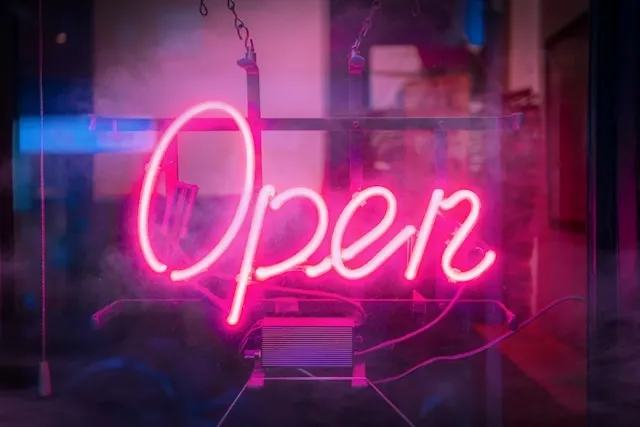How Do Neon Lights & Signs Work? Unveiling The Glow Behind Its Technology
They never fail to captivate with their vibrant glow, but how do neon lights actually work? In this post, we delve into the fascinating science behind these luminous displays and reveal the secrets of why neon lights glow. We will also compare the technology to more modern alternatives to help you determine which is better.

Key Takeaways
- Traditional neon signs work by using electrical currents to excite neon gas atoms within the glass tubing, causing them to emit photons of light.
- The key components of this process are glass tubes, electrodes, and neon gas inside the tubes.
- While iconic and eye-catching, traditional neon signs are not energy efficient and they can be vulnerable to damage.
- LED neon signs are a great modern alternative, mimicking the vibrant aesthetic with a safer, more durable, energy-efficient technology and design.
- We supply high-quality custom LED neon signs in a range of colors and flexible designs for businesses and individual use, so you can get a vibrant, personalized neon sign.
Table of contents
-
How Do Neon Lights & Signs Work?
-
Components Of Neon Lights Explained
-
What Is The Purpose Of Neon Lights? Applications Of Neon Signs
-
The Technical Side Of How Neon Lights Work
-
So What Makes Neon Lights Glow?
-
How Do LED Neon Lights Work Compared To Neon Signs?
-
Safety And Legal Aspects Of Using Working Neon Lights
How Do Neon Lights & Signs Work?
Neon signs make use of neon gas and an electrical current to produce their iconic glow. Neon lights are, essentially, glass tubes filled with neon gas. That gas is what we call a ‘noble gas’, which emits light when stimulated by electricity.
An electrical current is applied to electrodes at the ends of the glass tube, ionizing the neon gas. The process excites the neon atoms, causing them to emit photons and create that bright, colorful glow that we all know. The color of the light depends on the gas used and the coating on the inside - neon gas typically emits a red-orange light.
Many businesses and individuals use custom glass neon signs to display messages and symbols in luminous color that enliven the surrounding space.

Components Of Neon Lights Explained
There are several main components that make up neon lights:
- Glass tube: This is shaped into a range of designs and encloses the gasses and the light-emitting medium.
- Electrodes: These are placed at each end of the glass tube, and they conduct the electrical current into the gas.
- Gasses: Typically neon, or other noble gasses like argon, these are sealed within the glass tube.
When the electrical current is delivered through the electrodes, it ionizes the gas, which results in the atoms emitting photons that produce light. Each component is essential to the overall mechanism, working in unison to create the vibrant, glowing effect.
Experience custom LED signs with cutting-edge technology
Our custom LED signs use a simpler yet more advanced technology than traditional neon lights, and you can customize for a stunning aesthetic in any space.
What Is The Purpose Of Neon Lights? Applications Of Neon Signs
Neon is used in signs to create an eye-catching glow, and this serves several purposes. The most common uses of these signs are for commercial signage and modern art.
- Commercial uses: In retail stores, bars, and other commercial establishments, the bright, vibrant appearance of neon signs is ideal for advertising businesses and products, or for creating an ambiance.
- Modern art: The versatility and aesthetic appeal of neon lights is often harnessed by artists in their creations. They can help create eye-catching installations and sculptures.
There are many iconic examples of neon lights around the world. For commercial use, the world-famous ‘Welcome to Las Vegas’ neon sign is a celebrated feature of the popular tourist destination. And artists like Tracey Emin and Bruce Nauman have applied neon lights in their works.
Advantages Over Alternative Lighting Options
One downside of traditional neon signs is that they use lots of electricity in comparison to modern alternatives. LED neon signs offer several advantages over the classic neon light:
- Aesthetics: LED signs mimic the bright, vibrant glow of neon whilst offering more color options and design flexibility.
- Durability: LED signs are more robust, less vulnerable to breakage, and better able to withstand harsh conditions.
- Energy efficiency: LED technology is extremely energy efficient, consuming less power and generating less heat.
We supply high-quality custom LED neon signs as a bespoke, durable, and sustainable alternative to the outdated technology in traditional neon lights.
The Technical Side Of How Neon Lights Work
Neon light is produced via the principles of gas discharge and electrical excitation. The primary components of this are the sealed glass tube filled with neon gas, electrodes at both ends, and a high-voltage power supply.
An electrical current is applied to the electrodes, ionizing the gas inside the tube. The process of ionization excites the atoms, causing them to release energy that we can see in the form of light photons. The color of the light it emits depends on the type of gas and the specific coatings on the inside of the glass tubing.
The characteristic glow of neon gas is a red-orange color, but these luminous signs can have different colors when other noble gasses are used, like:
- Argon
- Krypton
- Xenon

Neon Lights’ Technology And How It Is Manufactured
Learning about neon lights involves understanding how they are made. The process of manufacturing begins with bending and shaping glass tubes into the desired writing or image, using a gas torch and skilled craftsmanship. Once this is done, electrodes are attached to both ends of the tube.
Air and impurities are removed from the tube through an evacuation process before filling it with neon gas. The tube is then sealed, before attaching the electrical components that deliver the high-voltage electrical current to the electrodes and give the user control over the sign.
Safety and quality control are essential factors of the manufacturing process. They will include:
- Checking for gas leaks
- Ensuring the electrodes are attached properly
- Testing the electrical system for consistent performance
The Working Science Behind Neon Light Bulbs
The physics of ionization in neon signs is down to electron excitation and photon emission. Here’s what makes neon lights glow:
- A high-voltage electrical current is delivered to the gas inside the glass tubing, providing energy to the neon atoms.
- The energy excites the electrons, which causes them to jump to higher energy levels.
- As the excited electrons return to normal levels, their energy is released as light photons.
The electron excitation process and resulting photon emission creates the bright, colorful glow we are used to seeing in neon signs.
Need a beautiful wall light for your space?
Create custom aesthetic neon signs with our online service and enjoy bespoke designs with the energy-efficient performance of colored LEDs and the iconic neon light look.
Create yours hereSo What Makes Neon Lights Glow?
Neon light is produced through a process we call gas discharge. The high-voltage electrical current excites the neon atoms in the gas inside the glass tube, raising the energy levels of their electrons. Those electrons then return to their normal levels, releasing that energy as visible light photons that create the iconic glow of neon signs.
Our custom LED signs, meanwhile, use light-emitting diodes (LEDs) to produce their glow. LEDs are made up of semiconductor materials that emit light as an electrical current passes through them. With specially-crafted PVC or silicone tubing, this light is dispersed to resemble the glow of traditional neon signs, creating a similar aesthetic with superior durability and energy efficiency.
How Is Light Produced In Neon Signs?
Different gasses produce different colors in neon signs as they have unique atomic structures and energy levels. While neon gas typically produces a red-orange glow, argon is known to create a blue light. Manufacturers often add phosphor coatings to glass tubes in order to achieve a wider range of colors.
Popular colors for neon signs include:
- Red
- Blue
- Green
- Yellow
Red is a powerful choice for grabbing attention, while blue and green have a calming effect for the surrounding space. Yellow offers warmth and versatility for use in a range of settings.
Durability And Maintenance Of Neon Lights
Neon signs are quite durable, with lifespans that can extend up to 8-15 years with proper maintenance. How long neon signs last often depends on your upkeep, which generally consists of cleaning and checking for signs of damage and electrical issues.
Common faults include:
- Flickering lights
- Broken tubing
- Dimming due to issues with the transformer
With regular inspections and prompt repairs, you can usually mitigate these concerns. However, traditional neon signs are very vulnerable to weather damage and the glass tubes are fragile. Our custom LED neon signs are not susceptible to these issues, and they offer even longer lifespan with lower energy consumption.
Come to us for long-lasting, vibrant signage solutions for any application.
How Do LED Neon Lights Work Compared To Neon Signs?
LED neon lights have a very different operative structure to traditional neon signs. Comparing LED neon vs glass neon lights, the glass ones use high-voltage electrical currents to excite gas atoms in glass tubing, while the LED ones use light-emitting diodes in flexible silicone or PVC tubing.
LEDs are significantly more energy-efficient, using as much as 80% less electricity than neon signs. As an example, a linear foot of a glass neon sign might consume 20 watts, while an LED neon light will only use about 1.2 watts per linear foot.
WIth such a substantial reduction in energy consumption, LED neon lights are more cost-effective in the long run. They are also usually less expensive to buy, and their 50,000-hour lifespan dwarfs the 8,000 to 15,000 hours of traditional neon signs.
Aesthetic Appeal And Usage Scenarios
LED custom neon flex signs offer vibrant color options, more flexibility in personalized designs, and safer handling compared to glass neon lights. With a sleek, modern aesthetic, they are ideal for a range of contemporary settings, home environments, and intricate designs.
Traditional neon signs, meanwhile, offer a vintage look with a warm glow. They work well in retro-themed spaces like bars as nostalgic signage. LED neon is the superior option for energy-efficiency and versatility in commercial and residential applications, while glass neon is the choice if you want authenticity and nostalgic charm.
Your choice depends on the desired ambiance, design complexity, and energy considerations.
Make your own custom LED neon sign with us
With our custom neon sign maker service, you get the radiant appearance of traditional neon signs without the complex chemical processes, instead working on LED technology.
Safety And Legal Aspects Of Using Working Neon Lights
There are several safety, and possible legal, considerations to be mindful of when using and maintaining neon lights:
- The high voltages of neon signs pose a risk of shock or fire hazards with improper installation and maintenance.
- Regular inspections and maintenance are necessary to identify and resolve issues like damaged wiring or cracked tubes.
- Some jurisdictions have specific regulations regarding the use and placement of neon lights in residential areas to prevent light pollution.
Our LED neon signs adhere to stringent safety standards, offering a safer, more flexible alternative with less risk and fewer regulatory concerns.
Health And Safety Concerns
You need to be mindful of health and safety concerns that relate to how neon lights work, particularly in relation to breakages and high voltages. First of all, the neon and argon gasses used in these signs are not toxic; the real danger lies in the potential injury from broken glass.
Additionally, improper installation can lead to electrical problems, and neon signs can even be a fire hazard. To ensure safety, handle your neon signs with care, avoiding issues that could cause cracked or shattered glass. The installation should be performed by licensed professionals and adhere to electrical codes and safety standards.
Regular maintenance and inspections help highlight potential safety issues early, keeping risk to a minimum. Our custom LED neon signs are a safer alternative, posing none of the dangers commonly associated with traditional neon signs.

Regulatory And Legal Considerations
Neon signs can be subject to certain regulatory and legal considerations, particularly in public spaces. You should make yourself aware of local building codes and zoning laws, as there may be stipulations for neon signs in terms of:
- Size
- Brightness
- Placement
Some jurisdictions limit neon signage in residential areas to preserve neighborhood aesthetics. Energy-efficiency standards may necessitate opting for more eco-friendly lighting choices. This would favor LED neon signs as they have lower energy consumption and a reduced environmental impact.
Businesses, in particular, should stay informed about these regulations to ensure compliance and avoid penalties. Our custom LED neon signs are much less likely to breach regulatory standards, making them a simpler signage solution with fewer considerations.
How Does A Neon Light Work?
How Does A Neon Light Work?
Neon lights work by using high-voltage electrical currents to excite the neon atoms in the glass tubing, which emit photons of light afterwards to produce the characteristic colorful glow.
What Makes A Neon Sign Glow?
It is a process called ‘gas discharge’ that causes the iconic vibrant glow of neon signs. A high-voltage electrical current and neon or argon gas are needed to achieve this.
